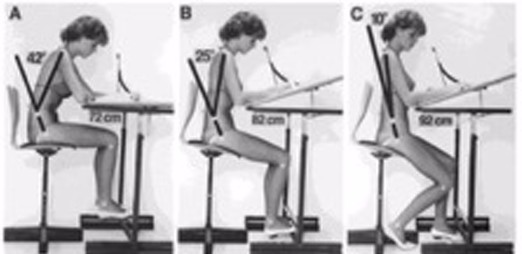Research Findings
Sitting, Standing and Lifestyle Choices

INTERVERTEBRAL DISC PRESSURES
Does sitting have a greater impact on intervertebral disc compression than standing? For a long time researchers have been examining the impact of posture on the intervertebral disc during daily life activities. Nachemson’s famous study1 illustrates the impact of various postures on intervertebral disc pressure compared to standing. In his study, slouched sitting (reduced lumbar lordosis) and standing in an unsupported forward lean increased intervertebral disc pressures. A systematic reveiw2 found low quality evidence that sit-stand desks may decrease workplace sitting but a more recent randomized controlled clinic trial supports the hypothesis that chronic LBP might be improved by the introduction of a Sit to Stand Workstation in an office environment.3

MANTAINING LUMBAR LORDOSIS
While one study questions the concept that higher disc pressures occur with sitting4, the most important aspect of a healthy sitting and standing posture may be the ability to maintain lumbar lordosis (or to reduce slouching). Cho et al5 found that sitting causes a reduction in lumbar lordosis and sacral slope when compared with standing and may lead to spinopelvic imbalance resulting in chronic low back pain.
Lordosis

HORSEBACK RIDING
So what kind of seat reduces slouching and improves lumbar lordosis? Mandel6 suggests something closer to a horseback rider’s seat. The horse back rider’s posture with knees below hips supports lumbar lordosis and allows the spine and pelvis to move freely without the need for a back support.

SLOPING SEAT
Mandel also advocates for a sloping seat, which allows for a larger hip angle to improve lumbar lordosis and supports more erect posture. It is suggested that a 135 degree trunk-thigh angle (close to that on the kneeling chair) is a neutral position for tension in thigh muscles.7

Standing Lordosis
KNEELING CHAIR
It is difficult to remain in erect posture all the time without support. A recent study8 demonstrates that lordosis is better maintained, when sitting on a kneeling chair compared to a usual flat chair, in upright as well as slumped posture in both clinical low back pain (CLBP) patients and healthy subjects alike. CLBP patients showed less reduction in lumbar lordosis between standing and sitting than healthy controls on both chair types and with upright and slumped postures.
90 vs 135 degree trunk/thigh angle
Kneeling Chair: Lordosis better maintained even in relaxed sitting
StolzDezkTM
. The StolzDezkTM features the option for a trunk thigh angle of 135 degrees, a chest support to reduce fatigue, and an air cushion seat that allows the pelvis to move, similar to the horseback rider’s seat.


Cranio-Vertebral Angle
Air Cushion seat
CRANIO VERTEBRAL ANGLE
Neck pain is also associated with increased use of computer screens.9 Tension Neck Syndrome often brought on by Forward Head Posture is common when working in front of the computer for more than 4 hours10. Forward Head Posture is measured by the cranio-vertebral angle. More than 40 degrees is considered out of normal range for sitting posture.11 The line of gravity should pass through the C6-C7 vertebrae. These are the most mobile vertebrae in the spine and can be affected by poor posture adaptations while using a computer.12. A normal cranio vertebral angle is supported when the body can maintain a vertical posture.

StolzDezkTM
Even vertical posture can allow the head to drift forward when looking at the computer screen. Many people with mild forward head posture feel fatigue and strain after sitting at their computers. The StolzDezkTM features a head support that requires only a light touch to feel supported.

StolzDezkTM
While there is little research demontrating that standing is better for your back than sitting, it is important to have the option to stand when a change of position is required. StolzDezkTM makes the adjustment simplw with a push of a button.

StolzDezkTM
While not all desks can easily move from one place to the next, StolzDezkTM easily folds with a touch of a button and can be wheeled quickly to the next location.
References
1. Nachemson AL. Disc pressure measurements. Spine. 1981;(1):93-7.
2. Shrestha N, Kukkonen-Harjula KT et al. Workplace interventions for reducing sitting at work. Cochrane Database Syst Rev. 2016 Mar 17;3.
3. Ognibene GT, Torres W, et al. Impact of a Sit-Stand Workstation on Chronic Low Back Pain: Results of a Randomized Trial. J Occup Environ Med. 2016 Mar;58(3):287-93.
4. Claus A, Hides J et alSitting versus standing: does the intradiscal pressure cause disc degeneration or low back pain? J Electromyogr Kinesiol. 2008 Aug;18(4):550-8. Epub 2007 Mar 7.
5. Cho I, Park S, et al. The Effect of Standing and Different Sitting Positions on Lumbar Lordosis: Radiographic Study of 30 Healthy Volunteers. Asian Spine .J 2015;9(5):762-769.
6. Mandal, A.C. 1996: Balanced sitting posture on forward sloping seat. www.acmandal.com.
7. Keegan JJ. Alterations of the lumbar curve related to posture and seating. J Bone Joint Surg Am 1953;35:589–603.
8. Vaucher M, Isner-Horobeti M, et al. Effect of a kneeling chair on lumbar curvature in patients with low back pain and healthy controls: A pilot study.
Annals of Physical and Rehabilitation Medicine 58 (2015) 151–156.
9. Korhonen T, Ketola R, et al. Work related and individual predictors for incident neck pain among office employees working with video display units. Occup Environ Med. 2003;60:475–482.
10. Gerr F,Marcus M, et al. A prospective study of computer users: I. Study design and incidence of musculoskeletal symptoms and disorders. Am J Ind Med. 2002;41: 221-35, 2002.
11. McAtamney L, Corlett E. Head and neck posture at computer workstation-What’s neutral? Applied Ergonomics. 1993; 24: 91-99, 1993.
12. Breen P, Nisar A et al. Evaluation of a single accelerometer based biofeedback system for real-time correction of neck posture in computer users. 31st Annual International Conference of the IEEE EMBS Minneapolis, Minnesota, USA, September 2-6, 2009.
Copyright © All Rights Reserved www.StolzeDezk.com
Take me Up




